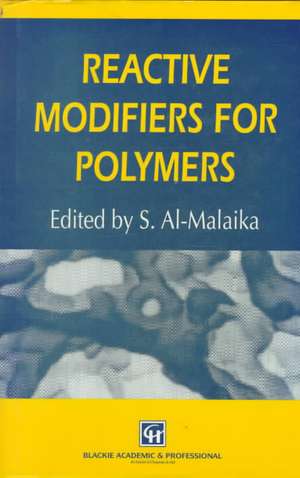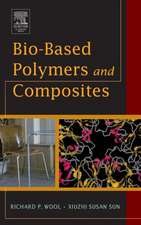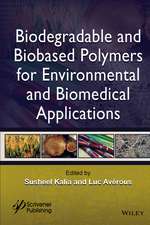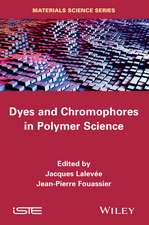Reactive Modifiers for Polymers
Editat de S. Al-Malaikaen Limba Engleză Hardback – 30 iun 1997
| Toate formatele și edițiile | Preț | Express |
|---|---|---|
| Paperback (1) | 1385.99 lei 43-57 zile | |
| SPRINGER NETHERLANDS – 28 sep 2011 | 1385.99 lei 43-57 zile | |
| Hardback (1) | 1228.77 lei 43-57 zile | |
| SPRINGER NETHERLANDS – 30 iun 1997 | 1228.77 lei 43-57 zile |
Preț: 1228.77 lei
Preț vechi: 1498.51 lei
-18% Nou
Puncte Express: 1843
Preț estimativ în valută:
235.12€ • 246.15$ • 194.55£
235.12€ • 246.15$ • 194.55£
Carte tipărită la comandă
Livrare economică 07-21 aprilie
Preluare comenzi: 021 569.72.76
Specificații
ISBN-13: 9780751402650
ISBN-10: 0751402656
Pagini: 400
Ilustrații: XVI, 400 p.
Dimensiuni: 155 x 235 x 24 mm
Greutate: 0.76 kg
Ediția:1997
Editura: SPRINGER NETHERLANDS
Colecția Springer
Locul publicării:Dordrecht, Netherlands
ISBN-10: 0751402656
Pagini: 400
Ilustrații: XVI, 400 p.
Dimensiuni: 155 x 235 x 24 mm
Greutate: 0.76 kg
Ediția:1997
Editura: SPRINGER NETHERLANDS
Colecția Springer
Locul publicării:Dordrecht, Netherlands
Public țintă
ResearchCuprins
1 Free-radical grafting of monomers onto polymers by reactive extrusion: principles and applications.- 1.1 Introduction.- 1.2 Free-radical grafting: an overall mechanistic view.- 1.3 Melt free-radical grafting: particular features.- 1.4 Challenges facing melt free-radical grafting.- 1.5 Recent advances in melt free-radical grafting.- 1.6 Concluding remarks.- Appendix l.A.- References.- 2 Modification of polypropylene by organic peroxides.- 2.1 Introduction.- 2.2 Background.- 2.3 Modifications of PP by organic peroxides.- 2.4 Future trends.- Acknowledgements.- Appendix 2.A.- 2.A.1 List of abbreviations.- References.- 3 Blends of polyamides and maleic-anhydride- containing polymers: interfacial chemistry and properties.- 3.1 Introduction.- 3.2 Interdependence of chemistry, rheology and morphology-interface.- 3.3 Relationships between morphology-interface and blend properties.- 3.4 Overall model and future trends.- Appendix 3.A.- 3.A.1 List of abbreviations.- References.- 4 Modification of polymer melts by oxazolines and their use for interfacial coupling reactions with other functional polymers.- 4.1 Introduction.- 4.2 Preparation of oxazoline-functionalized polymers.- 4.3 Interfacial reactions with other functional polymers.- 4.4 Modification of polymer melts by bis-2-oxazolines.- 4.5 Conclusions.- 4.6 Future trends.- Appendix 4.A.- 4.A.1 List of abbreviations.- References.- 5 Moisture cross-linkable silane-modified polyolefins.- 5.1 Introduction.- 5.2 Processes for cross-linking polyolefins.- 5.3 The chemistry of silane cross-linking.- 5.4 Silane-grafting processes.- 5.5 Silane copolymerisation processes.- 5.6 Structure and general properties of silane cross-linked polyolefins.- 5.7 Applications of silane cross-linked polyolefins.- 5.8 Other silane cross-linking approaches.- 5.9 Concluding remarks and future trends.- Appendix 5.A.- 5.A.1 List of abbreviations.- References.- 6 Reactive antioxidants for polymers.- 6.1 Introduction.- 6.2 Antioxidants and polymer oxidation: a mechanistic overview.- 6.3 Effect of chemical structure and physical factors on antioxidant performance.- 6.4 Reactive antioxidants and routes to antioxidant permanency in polymers.- 6.5 Concluding remarks.- Appendix 6.A.- 6.A.1 Abbreviations.- References.- 7 Synthesis of poly olefin graft and block copolymers by reactive borane reagents and applications in polyolefin trends and composites.- 7.1 Introduction.- 7.2 Synthesis of borane-functionalized olefinic polymers.- 7.3 Utilization of borane-functionalized polymers in graft and block copolymer formation.- 7.4 The use of graft and block copolymers prepared via borane- functionalized polymer intermediates in the compatibilization of polymer blends.- 7.5 Conclusions and future trends.- Acknowledgement.- Appendix 7.A.- 7.A.1 List of abbreviations.- References.- 8 Electron beam radiation graft modification of preformed polymer architecture.- 8.1 Introduction.- 8.2 Principles of pre-irradiation electron-beam grafting in inert atmosphere.- 8.3 Parameters affecting electron-beam grafting.- 8.4 Different polymer architectures suitable for electron-beam grafting.- 8.5 Applications of electron-beam grafting.- 8.6 Concluding remarks.- Appendix 8.A.- 8.A.1 List of abbreviations.- References.- 9 Thermoplastic elastomers based on elastomer/thermoplastic blends dynamically vulcanized.- 9.1 Introduction.- 9.2 The preparation of elastomer/plastic blends by dynamic vulcanization.- 9.3 Properties of blends prepared by dynamic vulcanization.- 9.4 Technological applications.- Appendix 9.A.- 9.A.1 Abbreviations.- References.








